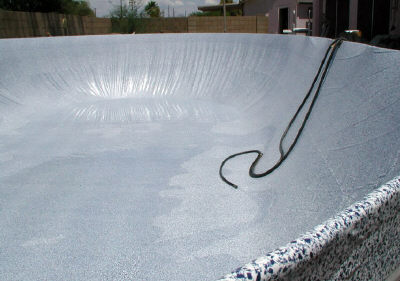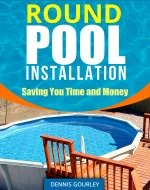Roundness and Liner Install
by Brent
I just put up the wall for a new 27'x54" pool today and will be doing the pool base and liner tomorrow.
At first the wall was nearly a foot away from meeting at the seam, but after several adjustments around the pool I was able to get the wall bolted up. Afterward I pulled several measurements in different areas of the pool and found that it is not completely round (unnoticeable to the naked eye) - I found it measuring 26'8" in one area, 26'10" in another, and 27' in another. I didn't go around the entire pool checking measurements from one side to the other, so it could be more off in other places.
How big an issue is this, should all measurements from 1 upright to another across the pool be the same? Is this something that will be fixed on its own once I fill with water?
Also, today was more windy than I expected and I was a nervous wreck about the walls falling over. I put the stabilizer bars around the top of the wall to help support and also temporarily attached an upright at every other base plate for extra support which will hopefully get it through the night.
I have a J-hook/V-bead liner and obviously need to pull off the stabilizer bars as well as remove or pull back the top plates from the uprights in order to hook the liner over the wall.
Tomorrow is supposed to be another windy one and I am concerned about this - can I hook the liner over the wall one section at a time so that I do not have to remove all of my wall support? If this is possible will it lead to more wrinkles? I like how you stretch in overlap liners and was curious if a similar method can be done with the v-bead. Thanks so much for your assistance, this site is great and has helped me a lot so far!
Hi Brent. I do feel roundness and leveling are the two most important parts of a pool installation. I make the pool round with a screw driver holding the end of a tape measure stuck into the middle of the pool. With this center point I measure each bottom rail and set it at the exact same radius. Once this is done and the pool is round I level each footplate. At this point the pool is perfectly round and level.
When laying out the bottom rails I try to set the gap at the connectors the way I think it should be based on past experience with that particular pool, as they are all different. When the wall goes up there is usually a small amount of adjustment to make it fit properly. I then back the wall up and make the adjustment at several different
If my wall was a foot from meeting I would take it completely down and reset every connector. That would be the only way to make up that much difference and still keep the gaps the same and the pool round. A pool that is not round, with even gaps, will show up later, big time, in the way the rest of the parts fit together.
In your situation I would not rely on top rail to top rail measurements, they could be very deceiving. I would find a center point and measure to the bottom track all the way around. You can make the pool perfectly round, even with the pool up, using this method. This will help but if your rail gaps are not all the same you could still have problems later on.
I also never leave a wall exposed to the wind, for even a short time, other than just a few rails at a time. I always have either the stabilizer rods taped to the wall, or the uprights and top rails installed, as I am installing the wall.
If the liner is an overlap I will install the pool framework as I am installing the wall, a few rails at a time. If I am using a beaded liner of any type I will either be installing the rods, or the bead receivers, as the wall is going up. This method never leaves a bare wall exposed to the wind. It just takes a small gust to blow a wall over and then the trouble begins.
Most of the time I stretch a beaded liner into place the same way I do an overlap one. The only difference is the frame I am working off of. With an overlap liner I have the top rails, uprights, and decorative caps in place. With a beaded liner I use the stabilizer rods or the bead receivers to support the wall and allow me to pull the liner over. Doing beaded liners this way I can get them centered perfectly and make use of the water to pull all the wrinkles out.

Since I like all my jobs to look professional I wait until the water is near the edge of the pool, all the way around, to decide if my liner will stay a beaded liner or become an overlap. If I can use the bead and have nice tight sides I will go ahead and do so. If doing that will leave the sides baggy and full of wrinkles I pull the excess liner over the wall and use coping to hold it in place, like a traditional overlap liner. Using this method, no matter how the liner fits, I get a nice looking job.



